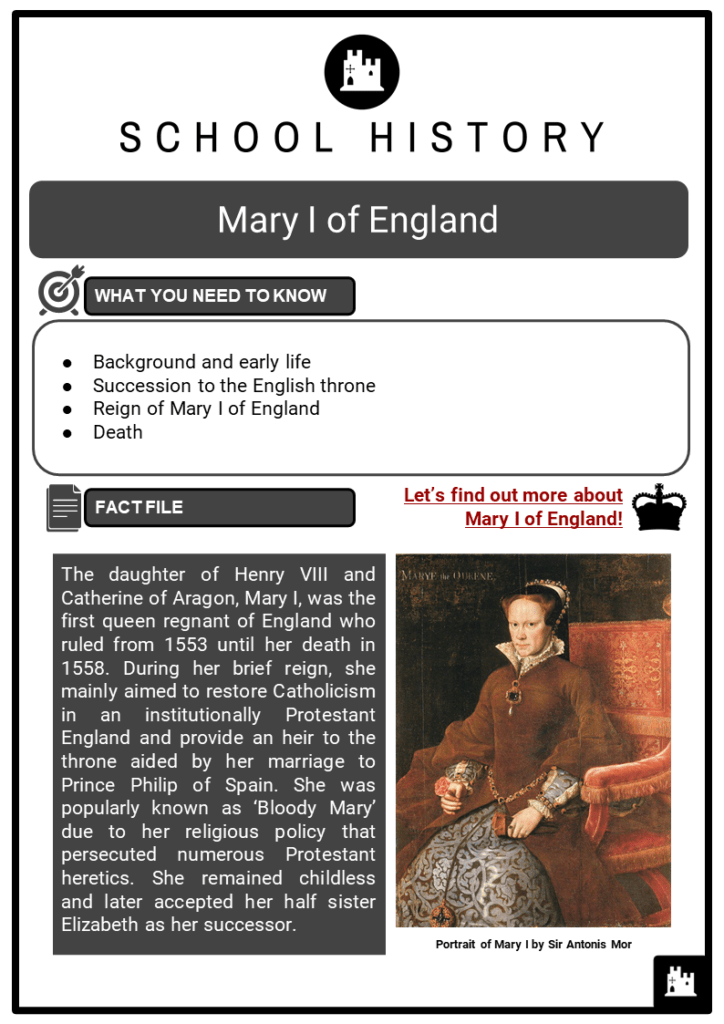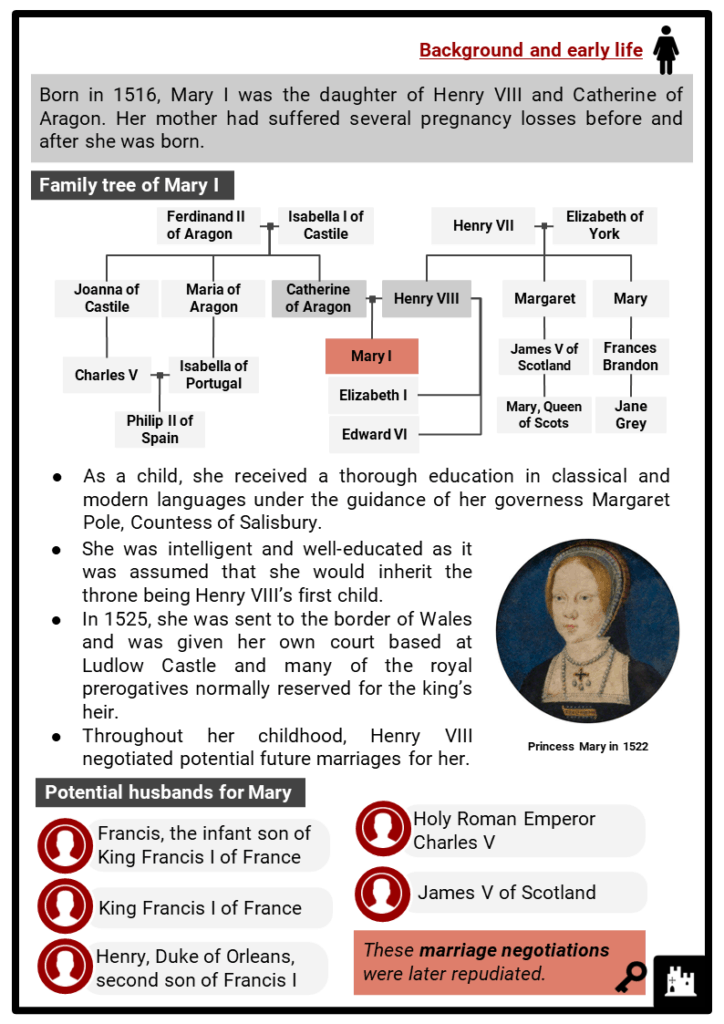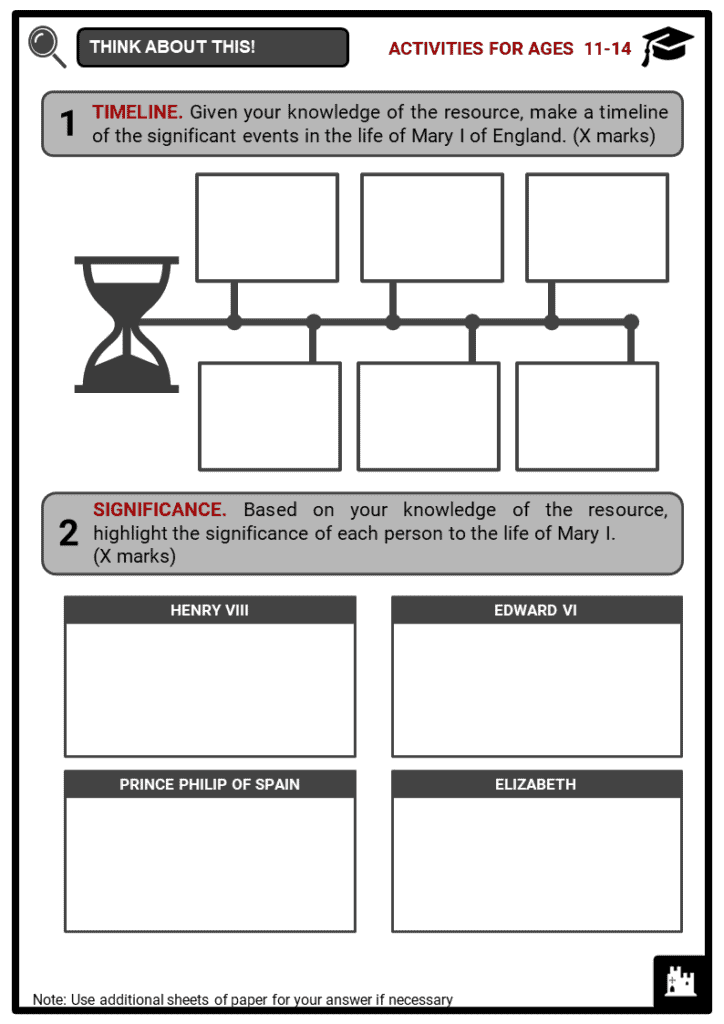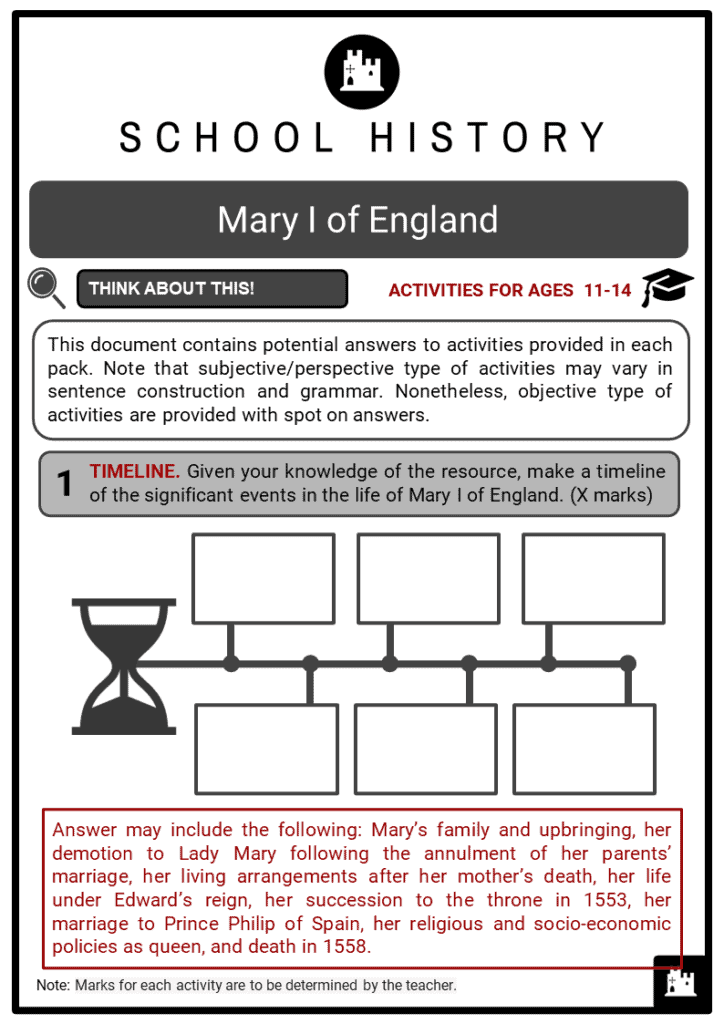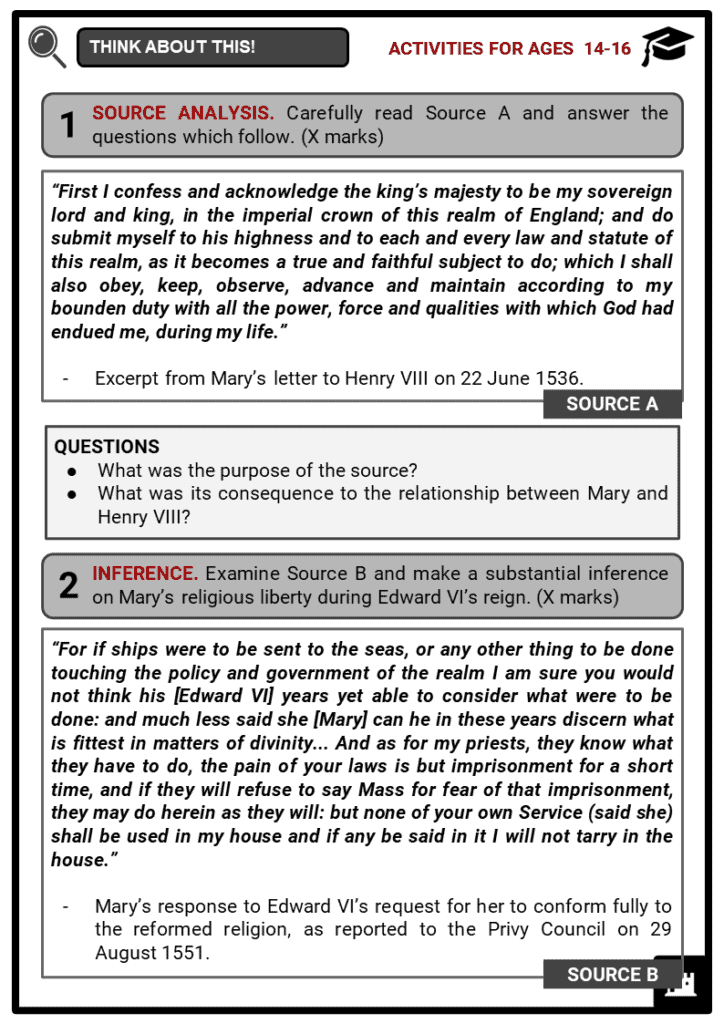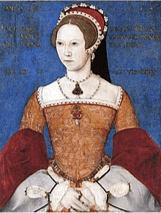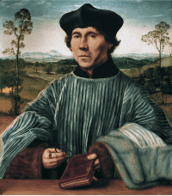Download Mary I of England Worksheets
Do you want to save dozens of hours in time? Get your evenings and weekends back? Be able to teach Mary I of England to your students?
Our worksheet bundle includes a fact file and printable worksheets and student activities. Perfect for both the classroom and homeschooling!
Table of Contents
Add a header to begin generating the table of contents
Summary
- Background and early life
- Succession to the English throne
- Reign of Mary I of England
- Death
Key Facts And Information
Let’s find out more about Mary I of England!
- The daughter of Henry VIII and Catherine of Aragon, Mary I, was the first queen regnant of England who ruled from 1553 until her death in 1558. During her brief reign, she mainly aimed to restore Catholicism in an institutionally Protestant England and provide an heir to the throne aided by her marriage to Prince Philip of Spain. She was popularly known as ‘Bloody Mary’ due to her religious policy that persecuted numerous Protestant heretics. She remained childless and later accepted her half sister Elizabeth as her successor.
Background and early life
- Born in 1516, Mary I was the daughter of Henry VIII and Catherine of Aragon. Her mother had suffered several pregnancy losses before and after she was born.
- As a child, she received a thorough education in classical and modern languages under the guidance of her governess Margaret Pole, Countess of Salisbury.
- She was intelligent and well-educated as it was assumed that she would inherit the throne being Henry VIII’s first child.
- In 1525, she was sent to the border of Wales and was given her own court based at Ludlow Castle and many of the royal prerogatives normally reserved for the king’s heir.
- Throughout her childhood, Henry VIII negotiated potential future marriages for her.
- Potential husbands for Mary
- Francis, the infant son of King Francis I of France
- King Francis I of France
- Henry, Duke of Orleans, second son of Francis I
- Holy Roman Emperor Charles V
- James V of Scotland
- The question of her legitimacy was raised during her father’s quest for annulment.
- When the annulment was finally granted in 1533 at the expense of England’s break with Rome, she was separated from her mother. Earlier that year, her father married Anne Boleyn, who was pregnant at the time.
- Following the annulment, Catherine of Aragon was demoted to Dowager Princess of Wales, whilst she was styled the Lady Mary rather than Princess.
- Her relationship with her father worsened. She was disallowed to visit her mother.
- With the death of her mother and the execution of Anne Boleyn in 1536, Mary’s situation was much improved.
- She made formal submissions to her father’s views and for the rest of his reign had a household suited to her rank.
- In 1537, she was made godmother to her half-brother Edward and acted as chief mourner at the funeral of her father’s third wife Queen Jane Seymour.
- Her father married for the sixth and last time in 1543. Queen Catherine Parr was able to bring the family closer together.
- She and her half-sister Elizabeth were returned to the line of succession, through the Act of Succession 1544, placing them after Edward.
- Mary and Elizabeth remained legally illegitimate.
- When Henry VIII died in 1547, his will placed her next in succession to the throne after her brother Edward VI and his children.
- Though Mary had her difficulties under the Protestant government of Edward VI, she was not badly treated.
- She was pious and remained loyal to her Roman Catholic faith when she was pressured by Edward VI to renounce her beliefs.
- For most of her half-brother’s reign, she lived on her own estates and refrained from attending court.
Succession to the English throne
- Edward VI fell ill and died on 6 July 1553. Mary’s claim to the throne had been difficult with Edward VI’s decision to exclude her in the succession.
- Edward VI’s death was followed with the succession of Lady Jane Grey, as stated in the late king’s ‘devise’.
- This was supported by John Dudley, 1st Duke of Northumberland, and the Privy Council.
- This came to be known as Northumberland’s plot.
- Lady Jane Grey was originally fifth in the line of succession according to Henry VIII’s will, but due to her religion and the influence of councillors, Edward VI had intended to leave her the throne.
- At age sixteen, Lady Jane Grey’s reign lasted from 10 July to 19 July 1553.
- Causes of Northumberland’s plot
- Opposition to Mary’s ascension
- Northumberland wanted to keep his power
- Mary gained popular support in 1553 because people believed in her dynastic legitimacy.
- She was received openly in London with a procession of over 800 nobles and gentlemen.
- With the support for Northumberland withered, the Privy Council switched sides and proclaimed Mary queen.
- For the first time in 400 years, the English throne was held by a woman in her own right.
- Northumberland and Jane were arrested and imprisoned in the Tower of London whilst all classes showed considerable loyalty to the Tudor dynasty.
Reign of Mary I of England
- At age 37, Mary became the very first queen regnant of England. She immediately ordered the release of the Duke of Norfolk, Stephen Gardiner and her kinsman Edward Courtenay from imprisonment.
- Having inherited an institutionally Protestant kingdom, she appointed her Roman Catholic supporters to the Privy Council but also kept experienced councillors who were previously Northumberland’s allies, such as Sir William Paget.
- She made Gardiner both Bishop of Winchester and Lord Chancellor. Her coronation ceremony was officiated by Gardiner on 1 October 1553 at Westminster Abbey.
- Although she was lenient to some, she handled the opposition in the government by ordering the arrest and imprisonment of Thomas Cranmer, John Hooper, Nicholas Ridley and other leading Protestant bishops.
- Mary directed her attention to finding a suitable husband. She made negotiations with Charles V’s son, Philip, trusting that a marriage would be helpful to her reign and an heir would solidify her aims for England.
- Prince Philip of Spain was the heir apparent to vast territories in Continental Europe and the New World.
- Fearing that England would be inferior and dependent on the Habsburgs, Mary was persuaded to consider marrying an Englishman.
- She insisted on marrying Philip, which was met with discontent and diminished her popularity.
- Her marriage to Philip was agreed on under the Act for the Marriage of Queen Mary to Philip of Spain, assuring that England would not become a satellite of Spain and parliament was to be called under the joint authority of the couple.
- Philip was a devout Catholic and saw himself as the defender of Catholic Europe.
- In essence, Mary’s marriage to the prince could be seen as a necessary step for her aims.
- What were Mary I’s aims?
- Restore Catholicism in England
- Provide an heir to the throne
- Gardiner supported the restoration of Catholicism in England but disagreed with the marriage of the Queen to Prince Philip.
- Instead, he argued that Edward Courtenay, Earl of Devon, was a more acceptable choice to the English people.
- Courtenay was rejected in favour of Philip and many people disagreed with the public announcement of the marriage between the Queen and Philip.
- This resulted in Wyatt’s Rebellion led by Sir Thomas Wyatt the Younger, Sir James Croft, Sir Peter Carew and Duke of Suffolk, and encouraged by the French ambassador.
- The rebellion was unsuccessful. Many were arrested and convicted. Several plotters were executed. Princess Elizabeth who was allegedly involved was imprisoned and put under house arrest.
- In line with her aims for the kingdom, Mary began the reintroduction of Catholicism from 1553.
- September 1553 Protestant churchmen such as Cranmer, Bradford, Rogers, Hooper and Latimer were arrested and imprisoned.
- October 1553 | First Statute of Repeal restored the Church to the position that it had been in during the last years of Henry VIII’s reign. Henry VIII and Catherine of Aragon’s marriage was declared valid; Edward VI’s religious laws were abolished. Mary I wanted to go further but was advised against it by her main supporters.
- 1554:
- Catholic bishops replaced Protestant bishops. All bishops were ordered to adhere only to legislation passed in the reign of Henry VIII.
- Latin became the language of the Church again and clerical marriage was outlawed.
- Mary I required the papal blessing to fully restore Catholicism. Cardinal Reginald Pole returned to England as papal legate.
- November 1554 | Second Statute of Repeal restored England’s religious position to that of 1529, complete with Papal authority. Heresy laws as they were under Henry VIII were also restored.
- The restoration of the heresy laws by parliament put the lives of the Protestants in England at risk.
- Prominent Protestants were tried for heresy and executed when found guilty.
- The persecution of Protestant heretics under Mary’s reign gained her the nickname ‘Bloody Mary’.
- The burning at the stake began on 4 February 1555.
- Some of the leading Protestants who were executed were Hooper, Ridley, Latimer and Cranmer.
- Between 1555 and 1558, an estimate of 284 religious executions were carried out.
- Consequently, around 800 Protestants fled to the continent in exile, whilst Protestant martyrs inspired the committed resistance to Catholicism.
- Mary’s popularity suffered with the implementation of Catholic restoration and persecution of Protestants.
- England was facing severe economic difficulties with its treasury in debt when Mary became queen. She attempted to resolve the economic and poverty issues during her short reign through the following:
- Plans were drawn up to reform the currency and withdraw the debased coins.
- The Muscovy Company was granted a Royal Charter in 1555 to open up new trade routes and find new markets for English goods.
- The Book of Rates was revised and detailed the customs duties that were to be levied on imports and exports.
- A commission was organised to investigate the shortcomings of the Crown finances and to recommend reforms.
- The 1555 Poor Act was passed, which required licenced beggars to display badges. Laws against the hoarding of grain were enforced and farmers were encouraged to grow more crops.
- In 1554, Mary was believed to be pregnant. By 1555, thanksgiving services were held in the diocese of London after false rumours spread that she had given birth to a son. However, it was most likely a false pregnancy.
- Following the false pregnancy, Philip left England to command his armies against France in Flanders.
- Philip became the King of Spain in January 1556 when his father abdicated.
- In 1557, he returned to England and persuaded Mary to support Spain in a renewed war against France. This was opposed by Mary’s councillors.
- England’s support for Spain’s war against France did not heavily burden the Crown’s treasury.
- However, Calais, the last continental possession of England, was lost to France during the war in 1558.
Death
- Following Philip’s visit in 1557, Mary was believed to be pregnant again with a baby due in 1558.
- Mary proclaimed in her will that Philip would be the regent during the minority of their child.
- However, no child was born, thus she accepted that her half-sister Elizabeth would be her successor.
- Her health became worse from May 1558.
- During an influenza epidemic, she died on 17 November at St James' Palace and was was interred in Westminster Abbey on 14 December 1558.
Image sources:
- https://upload.wikimedia.org/wikipedia/commons/7/7c/Mary_Tudor_by_Horenbout.jpg
- https://upload.wikimedia.org/wikipedia/commons/thumb/b/b7/Mary_I_by_Master_John.jpg/220px-Mary_I_by_Master_John.jpg
- https://upload.wikimedia.org/wikipedia/commons/thumb/3/3f/Der-kanonikus-stephan-gardiner.jpg/800px-Der-kanonikus-stephan-gardiner.jpg

